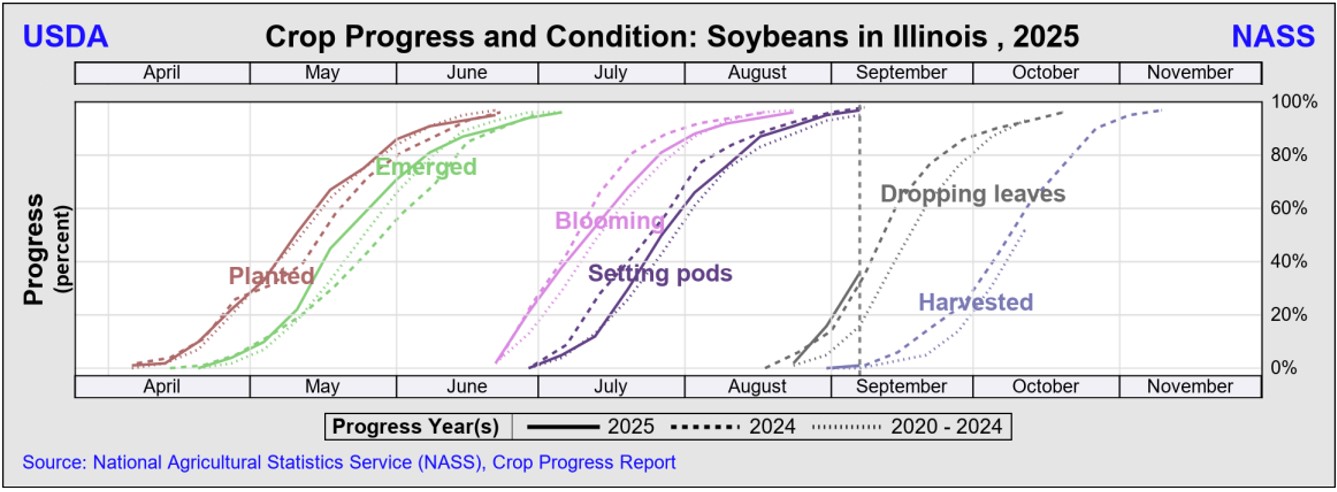The 2025 soybean crop as we approach harvest
You can also read the article in Portuguese and Spanish
While August rainfall is the “soybean maker,” July rainfall is also important to the podsetting process that sets up yield potential. July rainfall was plentiful overall in Illinois, but varied from an inch or two less than normal in parts of southern Illinois to more than twice normal amounts in western and northwestern Illinois. In contrast, August rainfall was less than normal over all but the northern edge of the state, with less than an inch in most of southern Illinois. The U.S. Drought Monitor Map from September 9 showed moderate dry conditions over all of southern Illinois, with pockets of abnormally dry conditions in east-central Illinois, and a “bullseye” of severe drought in parts of Champaign and Piatt Counties, as well as another in Perry, Washington, and Jefferson Counties. In the drier areas, soybeans planted late or growing in lighter-textured soils may have run out of water needed to finish filling pods normally.
The planting and emergence of the 2025 soybean crop were close to the average of the 2020-2024 period (Figure 1). Like corn, the soybean crop benefited from warm soils and little to no standing water following planting. This brought good stands, good root establishment, and good canopy color and leaf area across much of the state. Temperatures were 2 degrees warmer than normal during the summer, except for the last two weeks in August and into September, when temperatures averaged 2 to 8 degrees below normal. Overall, crop development, including flowering and pod-setting, occurred on a normal schedule. However, pod-filling was slightly earlier than normal, while leaf drop is running about a week ahead of schedule.

Crop condition and potential
The signs of how well the soybean crop is holding onto its yield potential are somewhat mixed. The time between setting pods and dripping leaves is often related to how many pods fill and how well they fill — that is, to yield. Dry soils may have helped accelerate maturity, but the cool temperatures — nighttime lows at Champaign were in the 40s to mid-50s over the past 20 days – do not seem to have reversed this, and in fact may have accelerated it. We’re not sure how temperature affects how the plant signals the plant’s move towards maturity. However, it’s possible that the seeds may not have grown as large as they would have if moisture had been more plentiful and temperatures had been higher over the past month. Data from Crop-CASMA showed that the mid-August NDVI (a satellite-based measure of crop canopy color) in Illinois this year was darker green than it was at the same time in 2024. But crop ratings have slipped since early August, to only 54% good + excellent by September 7. This is 14 percentage points lower than at this time last year, and is lower than current G + E ratings in Iowa (76%) and Indiana (60%). Figure 2a and 2b show photos from three relative maturity group varieties planted in mid-April and late May near Champaign.

The August 1 estimate for Illinois soybean yield is 65 bushels per acre, up 1 bushel from the 2024 yield. The September 1 estimate (released on September 12) still pegged Illinois soybeans at 65 bushels per acre. The USDA-NASS projections for soybeans have been fairly stable throughout the fall in recent seasons; however, we may see yield estimates decline as we move into the fall, especially if the weather remains drier than normal in the coming weeks. The 2025 trendline yield, based on yields from 1990 through 2024, is 62 bushels per acre, and statewide yields have been 63 or 64 bushels per acre each year since 2021. We can be optimistic that yield will be in this ballpark in 2025. At the national level, soybean yields are projected to average a record high of 53.5 bushels per acre, up 2.8 bushels from the 2024 yield.
Harvest moisture and timing
The September 7 NASS report shows 2 percent of the Illinois corn crop harvested, but no soybeans harvested yet in any state. We have heard of a few fields being harvested in Illinois, probably of early-maturity varieties planted early. The warm and dry weather in the forecast will continue to push the soybean crop rapidly toward maturity. Since soybean dry down faster than corn in these conditions, it pays to be ready to harvest them as soon as they reach 13% moisture or slightly higher. In warm, dry weather like we’re having now, it’s not unusual for the crop to go from 13% moisture at 10 AM to 10% moisture by mid-afternoon.
Having soybeans reach 10% moisture often increases yield losses due to shattering and seed damage (splits), as well as dollar losses at the elevator, since weights are not adjusted for soybeans below 13%. This is not the fault of the elevator: the problem is that there are hardly ever many soybeans coming in above 13% to mix with those below 13% and bring all of them up to 13%. Moving over-dry soybeans around increases splits and creates logistical problems as well. The best, and perhaps only, way to harvest soybeans at around 13% moisture is to harvest in the evening, maybe overnight, and in the morning before the dew dries off. That’s easier when nights are in the 40s or 50s and days are in the 70s; however, at higher temperatures and low dew points, it may not be practical.





